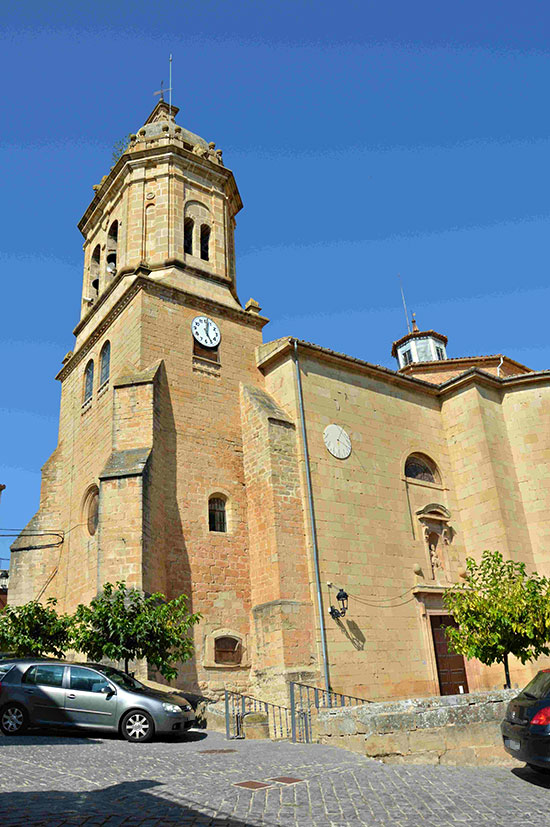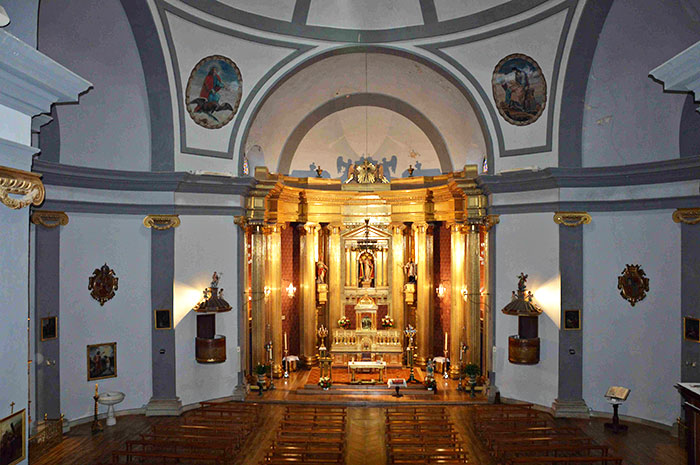30 August
Cultural Heritage, a privileged witness of History: Mañeru
Alejandro Aranda Ruiz
Parish Church of San Pedro, Mañeru
The great richness of the cultural heritage of Mañeru, and the lack of time, has forced us to choose the church of this village to focus the topic of this lecture.
The parish in the 16th century
The first church in Mañeru of which we have evidence is a medieval one whose style and form we do not know, and which remained until the 16th century. The population growth experienced in that century forced Mañeru, like most of the towns in Navarra, to enlarge its church. Thus, in 1538 the stonemason Pedro de Ilarreta was commissioned to build a bell tower, two chapels and a choir. The master died during the course of the work, leaving "a very large part" done, so we do not know to what extent these works were completed. Be that as it may, in 1561 the parish contracted the stonemason Juan de Iribas to build a side chapel and a sacristy. We assume that these works were done, because in 1596 the vicar general granted licence to build the front of the church and a chapel on the gospel side "corresponding to the one on the epistle side", the latter chapel we identify with the one made by Juan de Iribas.
In any case, it was in 1596 when the extension final of the temple was carried out following the traces and the project of the overseer of works of the bishopric Miguel de Altuna and executed by the Guipuzcoan stonemason Juan de Urbieta (c. 1540-1608). The work was completed around 1613 by Pedro de Urbieta, Juan's son, due to his death. Thanks to the appraisal of the works, we assume that the parish church in the 16th century consisted of a single nave with a main chapel, at least two side chapels covered with a ribbed vault and a sacristy covered in turn by another ribbed vault. The exterior walls were of well carved ashlar and decorated with architrave, frieze and cornice. In final, the church is characteristic of this time: a temple of predominantly Gothic language with some elements of Renaissance classicism.
The new church must have incorporated the main altarpiece that in 1556 the carver Juan de Iturmendi and the painter Hernando Belandia de Robledo agreed to build "of Romanesque workmanship and carving", with sculptures by Juan de Oberón, and which was finally polychromed by Pedro Latorre from Estella, who was paid in 1575.
To this altarpiece were added four other collateral altarpieces dedicated to Saint Catherine, the Virgin, Saint Barbara and Saint John the Baptist, which the parish contracted with Bernabé Imberto in 1600 and 1613 and which were polychromed in 1650 by Alonso de Logroño.
The parish in the seventeenth and eighteenth centuries
Once the construction of the church and its altarpieces were completed, the parish continued to acquire other essential pieces for worship, such as the choir stalls around 1660-1670, the evening psaltery made in 1619 by Jerónimo de Aro, the organ built in 1703 by José de Mañeru y Ximénez, and the relics.
Of all these elements, the extraordinary collection of relics that the parish possesses, most of which arrived in the town at two different times, is noteworthy. The first arrival took place in 1627 thanks to the mañeruco Fray Benito García de Dicastillo, second superior of the Benedictine monastery of Santa María la Real de Nájera. The relics, very diverse, included remains such as those of the cross of St. Andrew or a finger of St. Prudentius of Armentia. The second arrival dates from 1734, with the donation of the mañeruco Pedro Antonio García de Dicastillo, a priest who had lived years before in Rome. This lot was even more abundant than the previous one and included such unusual relics as the sponge with which Christ drank vinegar on Calvary or the hair of the Virgin. Catacomb remains, such as the corpi santi of St. Clare, were also included.
For their proper custody and veneration, the parish placed these relics on both sides of the main altar, inside two cabinets commissioned to the sculptor José Pérez de Eulate, which survived until 1928.
The new parish church (1780-1792)
As we have seen, by the 18th century the parish of Mañeru was already more than finished and equipped. The last thing to be built was the bell tower, which we know was under construction in 1715, the year in which the town council agreed to place the town's municipal clock in the tower. However, late in the 18th century, the growth of the population forced the construction of a new church.

Parish church of Mañeru, exterior. Photo: Alejandro Aranda Ruiz.
Thus, in 1780, Santos Ángel de Ochandátegui (1749-1802) was commissioned to draw the plans and the project of the new work, and the contract was signed with him in 1785. The works progressed at a good pace, and the church was inaugurated in 1792. The church built by Ochandátegui was attached to the base of the bell tower and the 16th century choir. Ochandátegui's church is composed of a large central square with semicircular apses at the chancel and lateral arms. On the west, the central square is connected to the tower structure by means of a two-bay nave. The interior stands out for the spatial unity provided by the repetition of pilasters with Ionic capitals decorated with garlands and a powerful entablature that runs around the entire interior perimeter. Regarding the roofs, the central space is covered with a dome of average orange on pendentives, the apse chapels with spherical caps and the nave with a barrel vault with lunettes. Also noteworthy are the two sacristies with their walls decorated with semicircular arches with pilasters and ceilings with moldings.
On the exterior, the church shows great simplicity, clean forms and forceful volumes. The only outstanding feature is the entrance door to the church, open on one side, which is decorated with a niche covered by a curved pediment with the image of St. Peter, carved in stone.
The temple in the 19th century
As had happened in the 16th century, once the construction of the church was completed, it was necessary to paint and furnish it.
In 1853, the church was richly painted by Santos Garrido. This pictorial covering, which contributed to reinforce the neoclassical character of the building through the simulated marble of the entablatures and cornices and the rich coffers with rosettes of the vaults, disappeared in the 80s of the twentieth century, surviving only the evangelists of the pendentives.

Parish church of Mañeru, detail of the interior. Photo: Alejandro Aranda Ruiz.
Focusing on the furnishings, some pieces were reused from the old church, such as the side altarpieces of St. Catherine and the Virgin, carved by Bernabé Imberto. We do not know if the other two of St. Barbara and St. John the Baptist were installed with them, but we do know that the parish must have had at least four altarpieces by then, since in 1800 the parish paid for four altar tables made by the Estella sculptor Lucas de Mena. position Likewise, the construction of the new church implied the commission of a new neoclassical style main altarpiece whose gilding was the responsibility of the painter Francisco Linares, who in 1806 collected the first installment for his work. Withdrawn in 1928, only the images of St. Peter, St. Fermin and St. Francis Xavier remain from this polychrome wooden altarpiece that simulated marble.
Complementing the main altarpiece were the pulpits built into the wall, on both sides of the presbytery, and which were equipped with two loudspeakers that were carved in 1810 by the sculptor Juan José Vélaz and polychromed by Domingo Echeverría.
Throughout the 19th century, the parish also renewed some pieces of silverware, such as the processional cross made in 1819 by the Pamplona silversmith Ignacio Iriarte. In 1857, another silver-plated metal cross for ordinary days was made by the silversmith G. Villarreal. In the same year, the same silversmith also made two scepters for the parish clergy position .
But in addition to altarpieces and gold and silver work, the church also acquired several canvases. In 1863 the Pamplona painter Mariano Sanz y Tarazona was paid for the painting he had done of the Baptism of Christ. The canvas sample a studied composition, a predominance of drawing over color and a discreet quality, although it is an important testimony, given the few documented works of Mariano Sanz. This painting was added to the 14 Stations of the Cross, painted in oil on canvas, and commissioned in 1858. Of unknown author, they are of higher quality than the Baptism scene.
The century ended in 1891 with the construction of the present Romantic organ, which was built at position by the Roqués Brothers and which, according to Sagaseta, belongs to the best period of this workshop.
The church in the 20th century: the main altarpiece
When the 20th century arrived, the neoclassical altarpiece of the late 18th century must not have fully satisfied the parishioners and their parish priest, who commissioned three designs for a new one from the Estella sculptor Santiago Michel, the famous Pamplona retablist Fermín Istúriz and the Echeverría Brothers of Pamplona. Subsequently, the projects were presented to Onofre Larumbe so that he could issue a report on the matter. design Larumbe ruled that none of the three projects were in keeping with "the style and general intonation of the building", so the parish priest decided to entrust the altarpiece to the architect Víctor Eusa, and in February 1928 the work was contracted to the Pamplona furniture manufacturers Arrieta y Compañía.
